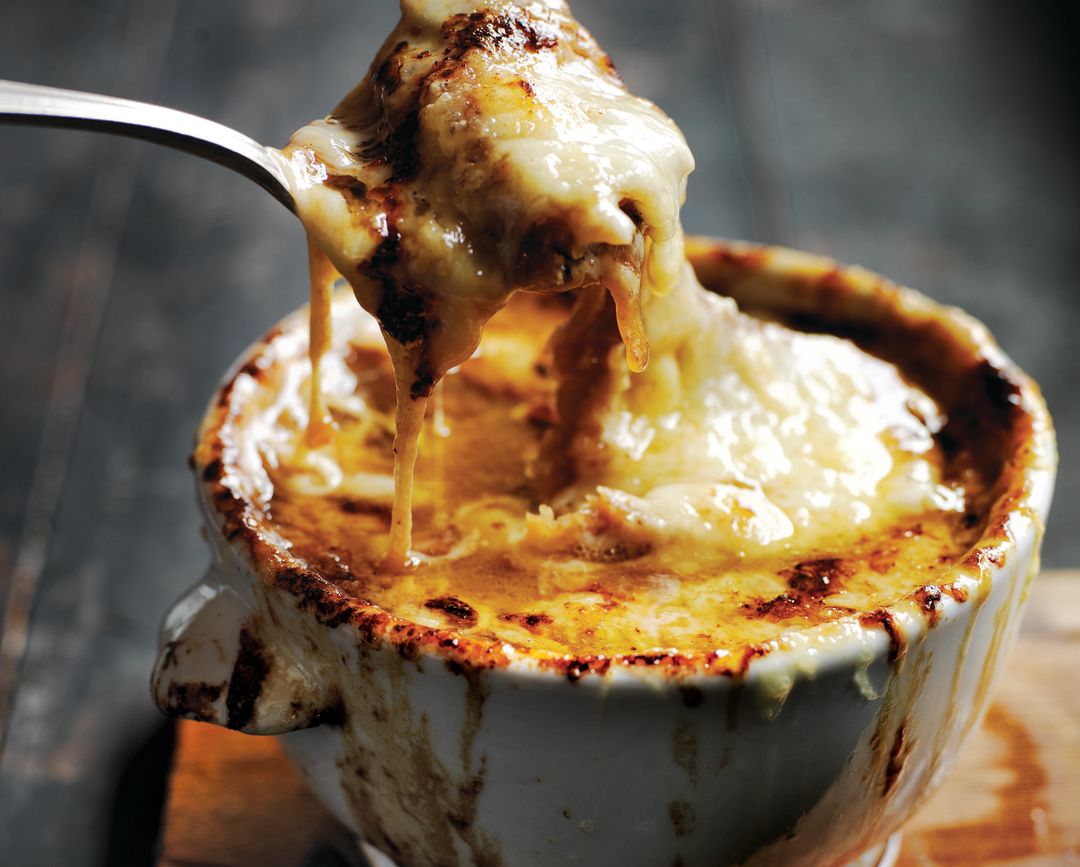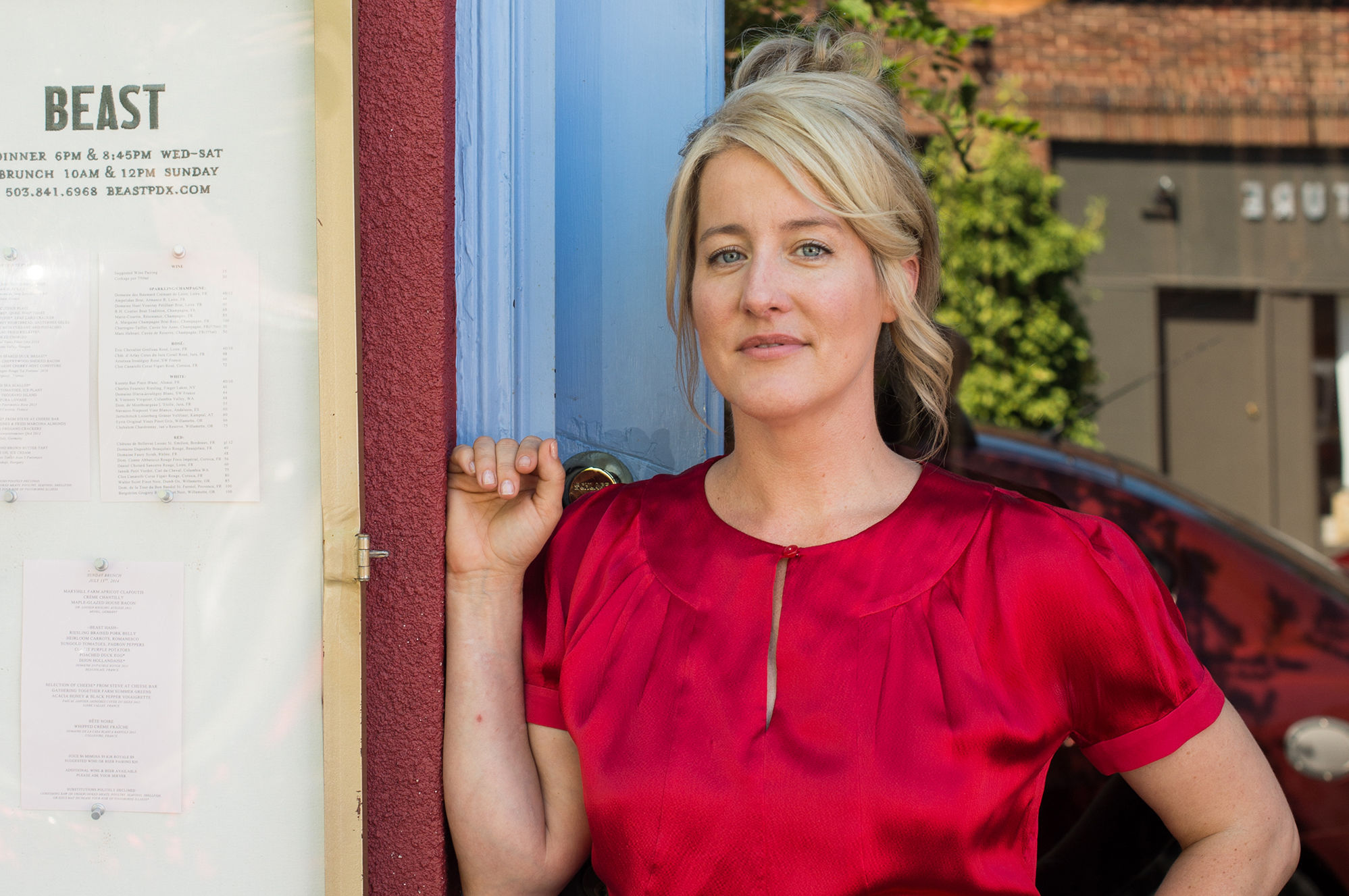How to Make Naomi Pomeroy’s Ballsy French Onion Soup

Image: Courtesy Chris Court
The first thing you’ll notice about Naomi Pomeroy’s maiden opus, Taste & Technique: Recipes to Elevate Your Home Cooking (Ten Speed Press, 2016), is that it is not a restaurant cookbook. One of Portland’s highest-profile chefs—a James Beard Award winner, media darling, and queen of Beast, that French-loving house of multicourse seasonality off of NE Killingsworth Street, Pomeroy says the oversight is intentional. “I wanted to make a cookbook for home cooks,” she says. “When The French Laundry [Thomas Keller’s three-Michelin-starred Napa restaurant] cookbook came out, everyone was oohing and aahing, but how many people [actually] cooked their way through it?”
So, no—you won’t find the recipe for her famous foie gras bonbons. What you will find: 380 pages of gorgeous, rustic food pornography; genuinely delicious recipes, from baked Camembert with Armagnac prunes and mushrooms to smoky tomato velouté with Parmesan straws; and quick dips into classic technique, like whisking egg whites for a soufflé and clarifying stock for consommé. If Taste & Technique has a flaw, it’s that Pomeroy’s natural hauteur—the personality of one of Portland’s most assured, innovative chefs—is lost.
French onion soup, the perfect antidote to a chilly autumn day and one of the few restaurant recipes in the book, is a strong illustration of Pomeroy’s cooking philosophy: self-taught Francophile sensibilities with ballsy tweaks. The impossibly rich umami bomb of a soup, a cold-weather star on Beast’s menu since it opened in 2007, owes its depth to leftover braising juices from previous dinners. That, and a very untraditional dash of Pomeroy’s seasonings of choice: fish sauce and Tabasco.
Classic French Onion Soup
Serves 6–8
- 2 tbsp extra-virgin olive oil
- 8 large yellow onions, quartered lengthwise and sliced into half-moons ¹⁄8 -inch thick
- 2¹⁄2 tsp salt
- ¹⁄4 cup dry sherry
- 2 tsp aged balsamic vinegar
- 2¹⁄2 quarts homemade stock or other high-quality beef or veal stock*
- ¹⁄4 tsp fish sauce
- ¹⁄8 tsp Tabasco sauce
- Freshly ground black pepper
- 6 to 8 baguette slices, each ¼-inch thick
- 2 tbsp butter, melted
- 1 clove garlic
- 1¹⁄4 lbs gruyère cheese, grated
CARAMELIZE THE ONIONS In an 8- to 10-quart heavy pot or Dutch oven, heat oil over medium heat. Add onions and 1¼ tsp of salt and stir often until the onions begin to turn translucent and become very soft, almost soupy, 20 to 25 minutes. Turn the heat to medium-low and cook for about 25–35 minutes longer, stirring every few minutes and allowing the onions to develop a fond, or crust, on the bottom
of the pan. Cook 45 minutes longer, scraping the fond often and making sure the onions don’t burn.
DEGLAZE AND ADD THE STOCK Add sherry and balsamic, and allow them to cook down for about 1 hour. Taste, adding the remaining 1¼ teaspoons of salt if necessary. Add the stock to the pot and turn the heat to low, gently simmering for 15 to 20 minutes, or until the flavors have melded. Add the fish sauce and Tabasco, a pinch of pepper, and adjust for salt as needed.
FINISH IN OVEN Preheat the oven to 350 degrees. Lay baguette slices on a baking sheet and brush with the melted butter. Toast in the oven until light golden brown, around 7 minutes. Remove the toasts, rub lightly with the garlic clove, and turn the oven to broil. Arrange oven-safe bowls on a baking sheet and ladle in the soup, filling them nearly to the top. Float 1 baguette slice on top of each bowl and sprinkle the gruyère, dividing it evenly. Place the bowls under the broiler for 5 to 7 minutes, or until the cheese is browned and bubbly. Serve immediately.
*Pomeroy recommends augmenting the stock by adding leftover braising liquid (up to 2 cups, from dishes like beef bourguignon or slow-cooked short ribs) or up to two tbsp of demi-glace (available at Providore Fine Foods). See below for her full homemade stock recipe.
Homemade Stock
Makes 5 to 6 quarts
- 8 pounds duck or chicken bones
- 5 pounds veal or young beef shank bones (a combination of knuckle bones and marrowbones)
- 2 pounds oxtails or cross-cut beef shanks (with lots of meat)
- 4 yellow onions, halved but not peeled
- 4 carrots, peeled and cut into 4-inch pieces
- 3 celery stalks, cut into 4-inch pieces
- 4 fresh or 8 dried bay leaves
- 1 head garlic, halved crosswise
- 1 tbsp black peppercorns, toasted
- 2 thyme sprigs
Preheat the oven to 450°F. Using your largest roasting pans, arrange the bones in the pans in a single, closely packed layer. Chicken and duck bones roast much faster than veal and beef bones, so keep them in separate pans, making it easy to remove them from the oven first. Roast the bones until deep, mahogany brown—past the point of golden—and the pan itself has accumulated dark brown, almost burnt-looking, bits of caramelized fat and proteins. Underroasting the bones will result in an unpleasant boney flavor, rather than a rich, deeply delicious flavor. You may have to roast the bones in batches, depending on the size of your oven. The roasting time is largely dependent on your oven. The quality of your stock depends on the quality of the bones and the degree to which you roast them. It may take as long as 2 hours, depending on how many bones you can fit without overcrowding them. Check them every 20 to 30 minutes and turn them occasionally to ensure they roast evenly. (This is a mostly passive activity.) Be careful to not over-roast the bones. If you have hot spots in your oven, be sure to move the bones around occasionally.
About 30 minutes after the chicken bones begin roasting, carefully pour off the liquid from the pan to keep the bones from steaming. I keep a ceramic bowl to the side of my oven for this purpose.
Once all of the bones are roasted, transfer them to a 6-inch deep, restaurant-quality hotel pan (see page 373) and turn the oven temperature to 250°F. Pour off any liquid remaining in the roasting pans, place the pans on the stove top over medium-low heat, and add about 2 cups water to each pan. Using a wooden spatula, carefully scrape up the dark brown bits from the bottom of the pans, creating a murky, watery gravy. Add this liquid to the hotel pan with the roasted bones. (If the bits on the pan are black and charred, skip this step, as they will give your stock a bitter finish.)
Add the onions, carrots, celery, bay leaves, garlic, peppercorns, and thyme to the pan with the bones, and then pour in water to come within about 11⁄2 inches of the rim. Cover the pan with parchment paper, and then with aluminum foil and place the pan in the oven. Cook for at least 12 hours or for up to overnight if you choose. I always leave the bones in the oven overnight.
Remove the pan from the oven, and then remove the bones and vegetables from the pan with tongs. Discard the bones and vegetables. Strain the liquid through a fine-mesh strainer into two large pots. Place the pots over high heat and bring the stock to a gentle bubbling simmer. Adjust the heat to maintain a gentle simmer and let the stock in each pot reduce by half, about 11⁄2 hours. Skim off any impurities (protein “foam” and fat) as needed every 20 to 30 minutes, and be sure the liquid is gently moving at all times. You should end up with a total of 5 to 6 quarts of highly concentrated stock.
At this point, the stock will be rich and flavorful and cloudy with proteins. Do not season it with salt or other flavoring agents (unless you want to drink it as is); the seasoning will happen in whatever recipe calls for the stock. Pour the stock into airtight containers and refrigerate or freeze until ready to use. It will keep for up to 1 week in the refrigerator or for up to 3 months in the freezer.
NOTE After refrigerating, it’s easier to skim off foam and fat. Simply lift off any fat that has come to the surface and discard.




